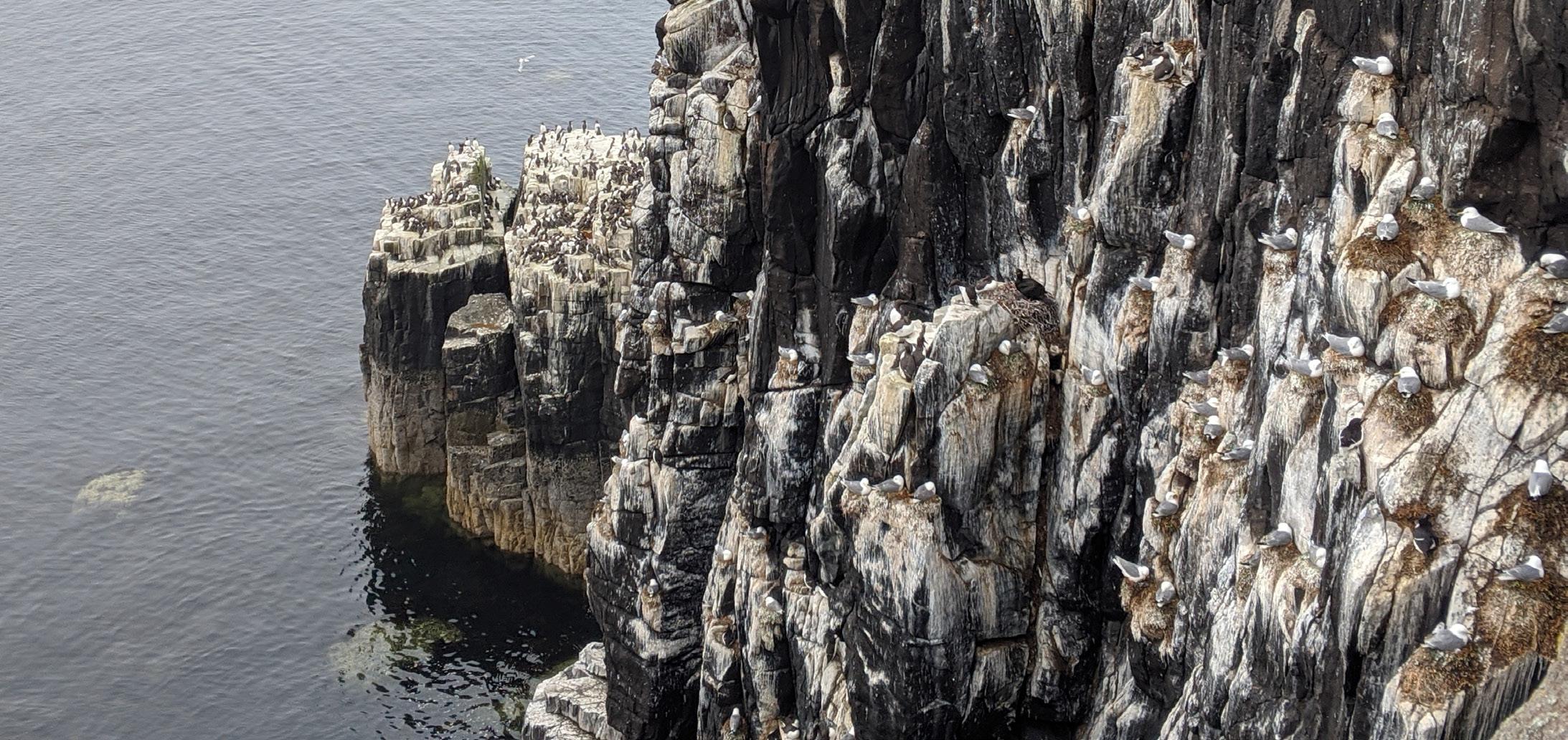
3 minute read
The Kittiwake
By Liz Humphreys, BTO
The Black-legged Kittiwake (hereafter Kittiwake) is a small gull that is associated with nesting on cliffs and is largely dependent on small shoaling marine fish such as sandeels and clupeids for food. Named after their iconic call “kittee-wa-aaake, kittee-wa-aake” they can be heard at their breeding colonies usually from February to August. Typically they will be found nesting in clusters, nestled in amongst other cliff nesting seabirds such as Guillemots, Razorbills and Fulmars. They are site faithful, returning to breed at the same nest structure, made from mud and vegetation, from one year to the next. From the middle of last century they have been increasingly recorded at inland sites – recognising buildings and bridges as suitable nesting sites – but their commitment to foraging at sea remains intact. Urban Kittwakes have not been universally welcomed, however, and conservationists have challenged the use of netting to dissuade them from their newly selected breeding habitat.
Identification guides often describe the adult Kittiwake as being gentle looking but what sets them apart from their closest sized counterparts – the


Common Gull – is their black legs, fully yellow bill and black ink-dipped wingtips. Immature birds lack the plain grey wings and have distinct black markings on the tips of their tail, upper wings and around back of the neck. They are classified as surface feeders since they are restricted to the uppermost layers of the water column for foraging. During the breeding season, Kittiwakes can easily achieve mean foraging ranges of just over 150 km.
Kittiwakes breed across the coasts and islands of Britain and Ireland with larger colonies traditionally concentrated in the Northern Isles of Shetland and Orkney. Colonies are sparser further south, particularly on the east coast of England. During the winter months they remain entirely at sea with some birds staying closer to home in the North Sea whilst others travel as far as the north-west Atlantic, between Newfoundland and Greenland.
Adult Juvenille
Data from the SMP, based on a subset of colonies, have shown a marked decline in breeding numbers with those in 2013 reported as being 70% lower than the baseline of 1986. However, there has been a partial recovery in since then and the latest report indicated that by 2019 numbers were 52% lower than the baseline. Data from the Seabirds Count census will be critical in determining the scale of this loss across Britain and Ireland and any changes in distribution that may have occurred. Breeding Success data reflects the effect of local environmental conditions, such as food availability, and SMP data show highly variable trends in the numbers of chicks per pair. There appears to be a possible increase in productivity between the years 2014–19 (noting low sample sizes), and are reminiscent of the early years of the SMP, up until the early 1990s, when Breeding Success was at its highest.
Fact Box
Status: Birds of Conservation Concern
‘Red-listed’, globally vulnerable.
Measurements: 108 cm wingspan, 410 g weight.
Breeds: north and west Eurasia and North America.
Winters: Atlantic south to North Africa and US.
Diet: marine invertebrates and fish.
Lifespan: 12 years typically. Maximum recorded is 28 years, 6 months and 5 days.
Breeding: starts at four years, single brood per year, two to three egg clutch size.
Nest sites: coastal cliffs and coastal artificial structures, including offshore platforms.

Fishing pressure was once regarded as the main threat to Kittiwake populations in the UK, this resulting in the closure of 20,000 square kilometers to the sandeel industry operating in the North Sea in the year 2000. Since then there has been a huge amount of research looking at the links between climate change and seabird populations and much of the focus has been on the relatively easy-to-study Kittiwake.
There is strong evidence for climate mediated bottom-up processes whereby oceanographic changes result in changes to their key prey species, phenology (timing of peak availability) and abundance (amount present), particularly in the North Sea. This is manifested as lower Kittiwake Breeding Success and survival rates and these declines are now being observed in counts of breeding adults. There are also concerns arising from their likely interactions with wind farms since they are known to fly at the height at which rotor blades operate and consequently they have been identified as being a species of high risk from collision with turbines. Predation at Kittiwake breeding colonies may also be an issue with reports of Peregrine and Great Skua predating Kittiwakes at some breedings sites in the UK. In some countries they can be targeted by other bird species such as the Raven and the White-tailed Eagle, with the latter known to significantly suppress both Breeding Success and population trends of the Kittiwake colonies affected. Kittiwakes were also badly affected by HPAI in 2022 although the true scale of mortality will be better understood through SMP counts.
Given the scale of pressures that have been acting on Kittiwakes populations, notably around food shortages, a more holistic approach around marine management, focusing on licenced activities (e.g., wind farm construction), and fisheries is important.
How To Help
There are 733 sites/plots in the SMP database containing Kittiwake colony count data and 72 with Breeding Success information.
Long-term monitoring of both breeding success and abundance better enables the drivers of population change to be determined.
Increasing this monitoring effort will help provide improved evidence on the conservation needs of the Kittiwake, identify where more research may be needed and help to track the outcomes of relevant policy measures.










